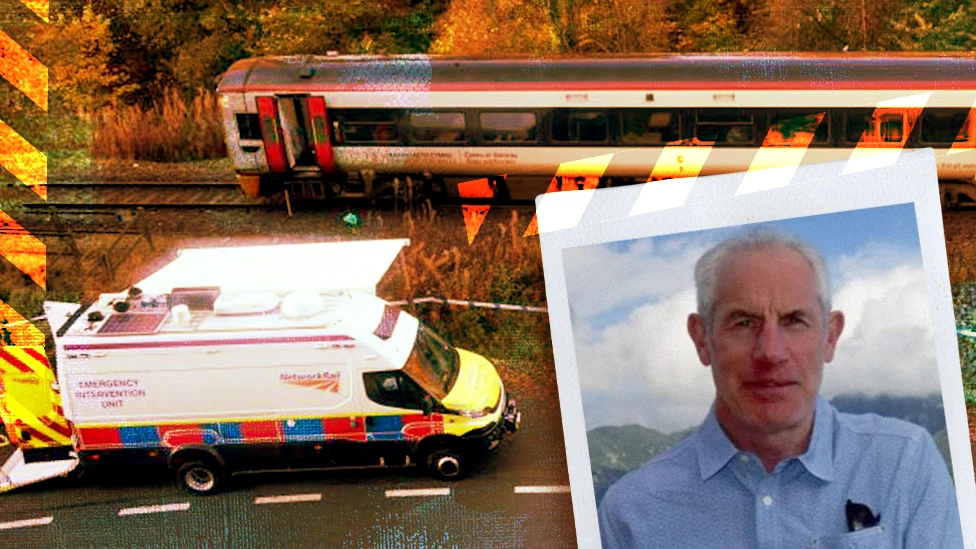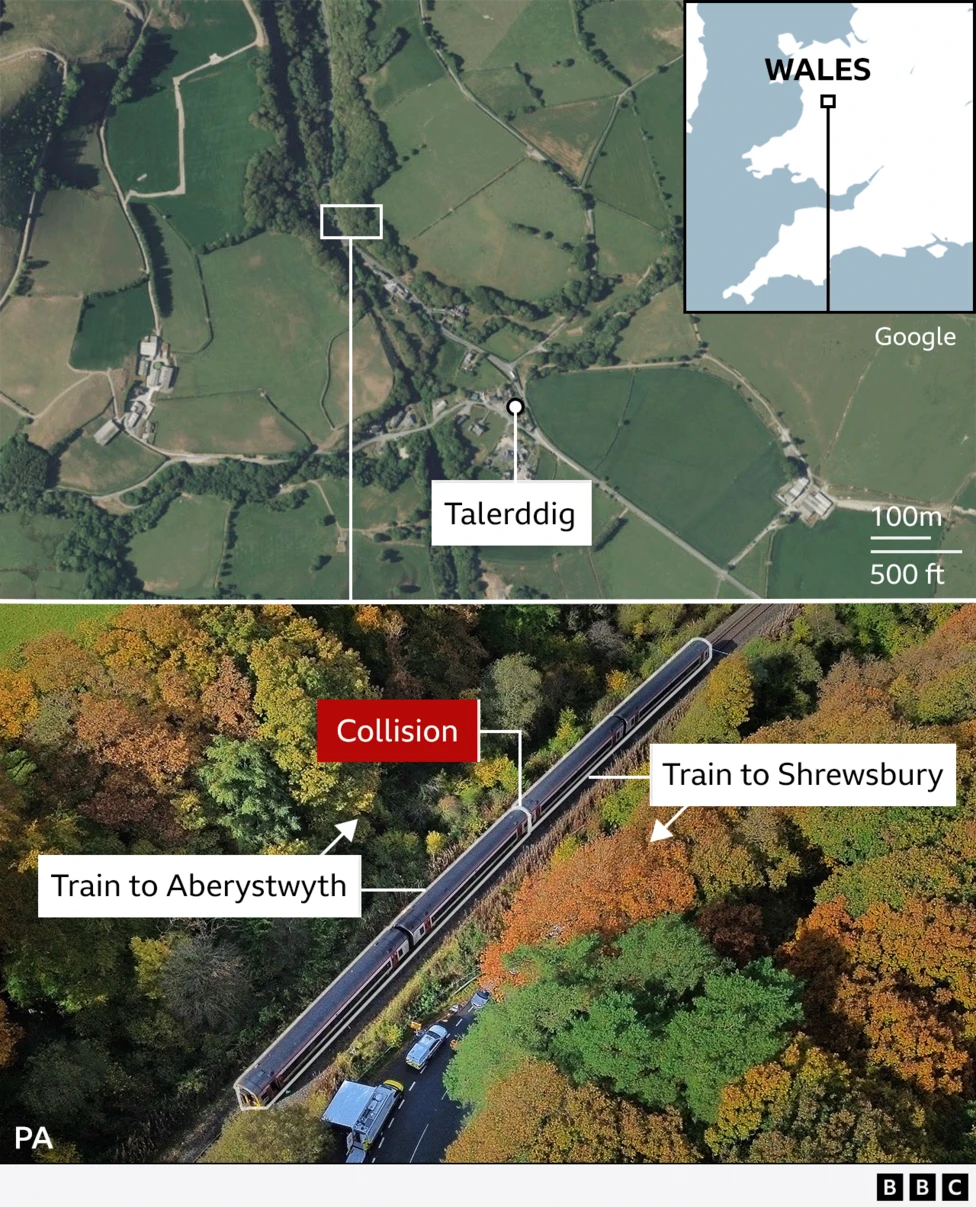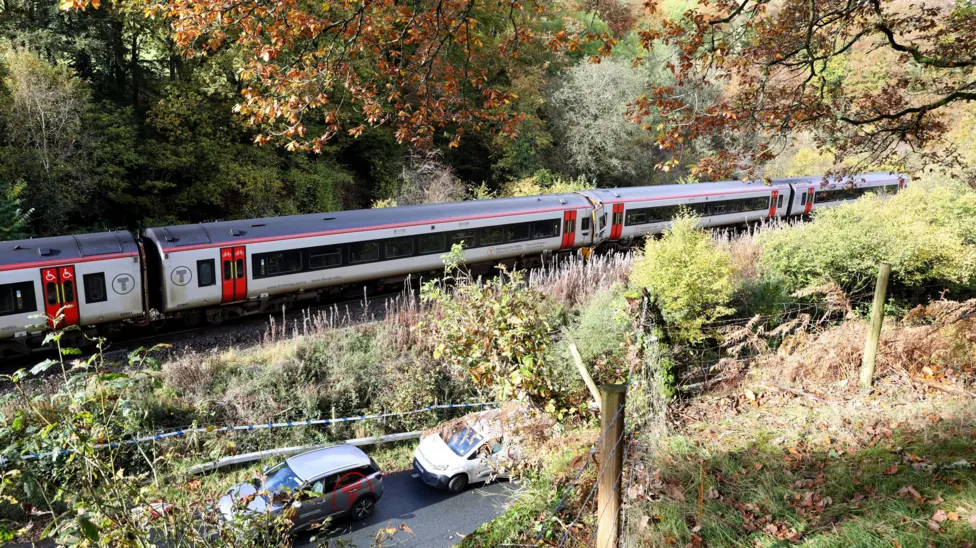On board the 18:31 to Aberystwyth as it smashed into another train On Monday evening, Jonah Evans was relaxing on a train, watching a Netflix drama and completely unaware he was about to be involved in a fatal train crash.
On Monday evening, Jonah Evans was relaxing on a train, watching a Netflix drama and completely unaware he was about to be involved in a fatal train crash."The driver comes running through the doors and shouts ‘brace yourselves, brace yourselves, we're going to hit another train’," says the 25-year-old.
He had just seconds to get into position before impact. "I was thinking… ‘it’s been a good ride, it's been a good life’."
One passenger died, four were seriously injured and a further 11 people required hospital treatment following the crash.
The artist and graphic designer had just spent a weekend celebrating his birthday with friends in Bristol and was heading home to Borth, Ceredigion, when the crash happened at about 19:30 BST.
He says that after his train hit a stationary one, everything felt like it was in slow motion.
Passengers on the 18:31 westbound service from Shrewsbury to Aberystwyth, were thrown from their seats. Mr Evans was uninjured, apart from whiplash.
"Seeing all those people upset was horrible.... it kind of feels like a fever dream," he says.
"This one girl was really crying out, she was at a table seat and it proper hit her in the middle of her body and she started throwing up," he says. "She started crying quite a lot... it was pretty horrendous."
He recalled seeing people around him with rib injuries, one person with a dislocated or broken arm and another person who had lost some teeth.
Another passenger Bethan Evans, who was knocked unconscious on the same train as Mr Evans, recalled seeing waking up to find passengers "flown out of their seats".
"The last thing I remember is reading one of my books and looking at the time," she says. "I saw a few people with broken bones and hearing emergency CPR being called and a lot of staff running down."
Anthony Hurford, who was on the other train - the 19:09 train from Machynlleth to Shrewsbury - found himself on the floor "wondering what the hell had happened".
"The word that keeps coming to my head is just brutal really," he told BBC Breakfast. "Somehow my body bent the leg of a table and ripped it off its bolts attached to the wall. Suddenly I was on the floor with my laptop strewn ahead of me."
Tudor Evans, 66, from Capel Dewi in Aberystwyth, Ceredigion, who was in the second carriage, died following the crash - which happened near the village of Llanbrynmair in Powys.
On Thursday, his friend Iestyn Leyshon told the Newyddion S4C app that he and his wife had "just begun to travel after years of work and then this tragedy happens".
The couple were returning from a holiday in Italy at the time of the crash. His family have thanked people for "kind messages and support", and asked for privacy.
How did the trains crash?
The crash happened on the Cambrian Line on a single track, close to a passing loop where opposite travelling trains can pass each other.
The Rail Accident Investigation Branch (
RAIB▸ ) said initial evidence suggested the crash occurred at a speed of approximately 24 km/h (15 mph).
It said it had deployed a team of inspectors to the site and on initial inspection found evidence that wheel to rail adhesion was relatively low, suggesting the train may have entered into wheel slide when braking. It said low adhesion would be an area of ongoing investigation. But what is low adhesion?
"That’s the jargony way of saying that the trains’ wheels are not gripping the top of the rail properly so you’re getting a sliding situation," says rail engineer and rail and transport writer Gareth Dennis. "So if the breaks are being applied the train is just sliding along on top of the rail."
He says it could be caused by fallen leaves "or sometimes you get very strange combinations of mist and rain that can end up creating a bit of an oily surface on top of the rail head and that’s extremely slippery. What will be interesting is understanding why we got to a situation where the rail was so slippery as a train hit another train," he says. "We have systems in place to prevent that from happening and those haven’t worked so we ned to understand why and that might require some introspection from the industry."
How common are train crashes in the UK▸ ? A full report into the crash is expected to take several months
A full report into the crash is expected to take several months“The reason rail incidents become big news like this is because they’re extremely rare events and that’s a good thing," says Mr Dennis.
The National Rail website states that train travel "remains one of the safest modes of transport in Great Britain".
One of the UK's most high-profile train accidents of last year was in September 2023, when the Flying Scotsman collided with stationary carriages at Aviemore Station in the Scottish Highlands, injuring two people.
The last train crash in Wales happened in 1991 inside the Severn Tunnel, which allows travel between south-west England and south Wales. On 7 December, 1991, the 08:30 from London Paddington to Cardiff Central was stopped at a signal at the tunnel’s entrance. The train’s driver was advised of a signal failure and told to proceed with caution, but about three miles into the tunnel, it was rear-ended by a class 155 Sprinter travelling from Portsmouth to Cardiff. A total of 185 people were injured in the collision, five of whom were seriously hurt.
It is not yet clear when we will find out exactly what happened on Monday.
Network Rail's route director, Nick Millington, says the investigation is going to be "complex".
TfW chief operating officer Jan Chaudhry-van der Velde says a full report would take several months to be processed.
Mr Dennis says it is imperative the public were given clear answers.
"To reassure the public the industry needs to be honest, not hide behind 'well the regulator said this, the regulator said that' and be honest with the public about how this has happened," he says.
He says after the RAIB gives its final report the industry should "respond constructively and in a way that shows some contrition that something has gone wrong".
"Because something has gone wrong here," he says. "For there to be two trains crashing into one another and resulting people being injured and worse, something has gone wrong."





